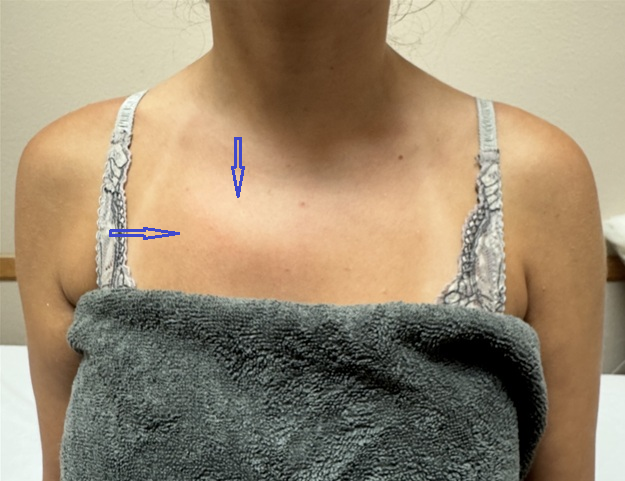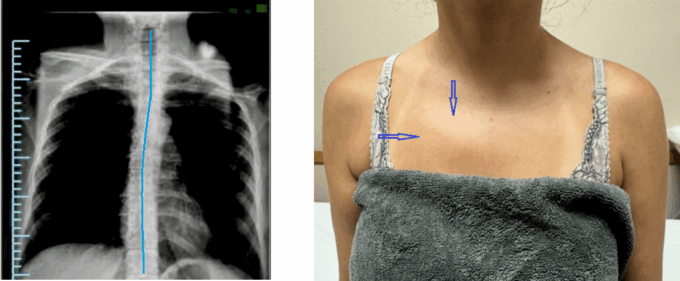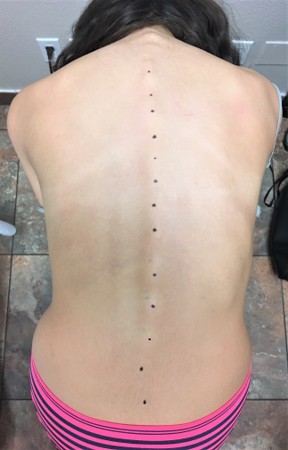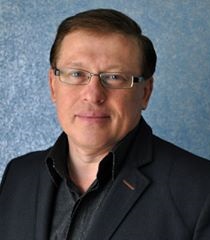The patient is a 30-year-old nail technician who presents to our clinic with complaints of acute and sometimes burning pain in the mid-back, between the shoulder blades. The intensity of the pain increases significantly by the end of her work in the salon. Do you have any suggestions on the cause based on visual observation?
Science Of Massage Institute
Thank you to everyone who took the time to post comments. It was very refreshing to see such wide engagement from therapists. Here is a list of proposed causes of our patient’s pain:
- Tension and spasms in the rhomboids
- Tension and spasms in the trapezius
- Tension and spasms in the pectorals
- Tension and spasms in the anterior scalene
- Tension and spasms in the rotator cuff
- Tension and spasm in Levator Scapulae
- Upper rib displacement
- T spine misalignment
- Cross syndrome
- Nerve compression
- Incorrect ergonomics
- Winged scapula
- Lower back spasm
- Spasm in the diaphragm
- Visceral disorders
Interestingly enough, comments from 1 to 11 are correct. The patient exhibited some of the somatic symptoms mentioned in the comment, or may exhibit them. However, they are not the original problem; rather, they are brain compensatory reactions amplified by the type of work. If treatment is provided for the compensatory reactions, it will bring temporary relief, as the initial trigger was not fully addressed. Several comments were spot on, pointing to the real trigger of somatic dysfunctions in our patient: Scoliosis.
Please compare the right and left parasternal areas, paying particular attention to the right side of her upper chest. There is a visual bulge in her right parasternal region (indicated by blue arrows in the photo).
Thus, the patient’s anterior chest suggests the possible presence of an early stage of Scoliosis with thoracic curvature directed to the right.
The patient suggested visiting her family doctor, who referred her for an X-ray. Radiologist confirmed the 1st-stage of thoracic curvature (indicated by the blue line on the X-ray).
She was never diagnosed with Scoliosis, and it was definitely the pediatrician’s fault. The 1st stage means that during her late puberty, the thoracic vertebrae began to rotate, and curvature started to form, but it stopped because she finished growing. Secondary curvature in the lumbar spine didn’t form since her growth stopped.
At this stage, Scoliosis can be suspected clinically by observing anterior chest differences and deviation of the spinous processes when the patient bends forward in the standing position and the therapist runs fingers along the line of the spinous processes. In the picture below is another one of our patients with 11 degrees of lumbar scoliosis, which is not visible when she stands straight. Bending forward immediately shows the presence of the lumbar vertebrae rotations and curvature. Black dots are the tips of the spinous processes.
The presence of visual differences in the parasternal areas is due to the upper ribs’ anterior displacement caused by the rotation of the bodies of the upper thoracic vertebrae. In this scenario, it is useless to treat her middle back pain in the form of different syndromes of muscle dysfunctions since the upper thoracic curvature must be decompressed first.
Her symptoms were completely eliminated after five sessions of the Medical Massage protocol for Scoliosis. Therapy involved detailed work, layer by layer, on the soft tissue on all sides of the chest. On the back, stimulating techniques were applied to the convex side, and inhibiting techniques were applied to the concave side of the curvature. The upper thoracic curvature was additionally decompressed through stretching, the application of respiration-resisting techniques, and recommended homework.
The vertical decompression of the thoracic curvature using a chin bar after a hot shower will allow her to live a productive life without pain and dysfunction.
CONCLUSION
Early stages of scoliosis are frequently missed by parents and pediatricians. However, they cause different somatic symptoms later in life. Since the curvature(s) are mild, their presence can be suspected if the therapist knows what to look for, and it is suggested that the physician be consulted. The basic X-ray will confirm or reject suspicions. Therefore, always check the position of the shoulders, scapulae, and anterior chest, comparing both parasternal areas to ensure that you are taking the appropriate steps in your treatment strategy and knocking on the correct door.
Evaluation of each patient is the most challenging part of Medical Massage, since following symptoms frequently leads therapists in the wrong direction, while the real trigger remains hidden and unaddressed. This is why SOMI invests so much in training (visual observation, correctly conducted clinical interview, layer-by-layer palpation, and testing) to read each patient as an open book. Don’t be misled by compensatory reactions formed by the brain secondarily; identify the trigger and slowly suffocate it.
Join the Science of Massage Institute for training in Medical Massage based on modern science and clinical application. SOMI is the only source of data backed by scientific and clinical references: Medical Massage Courses & Certification | Science of Massage Institute
ABOUT THE AUTHOR
Please click here to read Dr. Ross Turchaninov’s bio: https://www.scienceofmassage.com/editorial-board/
Category: Blog




